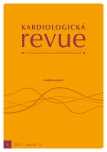Non-invasive pulse wave analysis in patients with acute decompensation of chronic systolic heart failure.
Authors:
O. Ludka
Authors‘ workplace:
ICRC Brno
; Interní kardiologická klinika FN Brno a LF MU, Brno
Published in:
Kardiol Rev Int Med 2011, 13(4): 241-248
Overview
Introduction:
In recent years an increasing number of evidence that the pathophysiology of heart failure, arterial wall stiffness applied. Increased pulse pressure is associated with increased cardiovascular morbidity and mortality in patients with asymptomatic left ventricular dysfunction and also in patients with mild heart failure. Conversely, decreased pulse pressure according to some work associated with increased mortality in patients with acute decompensation of chronic heart failure in patients with advanced heart failure and is also associated with elevated B-type natriuretic peptide (BNP).
Aim:
To determine the value of pulse pressure and other parameters of pulse waves through the non-invasive analysis of patients hospitalized for acute decompensation of chronic systolic heart failure.
Methods:
A prospective monocentric study with a focus on non-invasive pulse wave analysis using an apparatus SphygmoCor. Patients: 130 patients, 77% men, 23% women, age 70 years, body mass index 28.4 kg/m2, the etiology of chronic heart failure – 65.9% of ischemic heart disease, dilated cardiomyopathy 29.5%, 4.6% other , long-term NYHA I/II/III – 17/41.9/41.1%, on admission – oedema of the lower extremities 58.9%, rales in the lungs 88.3%, orthopnea 53.1%, BNP at admission 1765,7 pg/ml, at dicharge 962.3 pg/ml, left ventricular ejection fraction 27.5%, length of hospital stay 9 days.
Results:
(median, 5 percentile, 95 percentile), pulse pressure 32, 18, 59 mmHg, augmentation pressure 6, 0, 19 mmHg, augmentation index 17, 2, 37.
Conclusion:
Patients hospitalized for acute decompensation of chronic systolic heart failure have after stabilization lower value of pulse pressure, augmentation index, augmentation pressure compared to reference values.
Keywords:
chronic heart failure – non-invasive pulse wave analysis – pulse pressure – augmentation pressure – augmentation index
Supported by grant Ministry of Health Czech Republic 10422-3/2009.
Sources
1. Weber T, Auer J, Lamm G et al. Arterial stiffness, central blood pressure, and wave reflections in cardiomyopathy – implications for risk stratification. J Card Fail 2007; 13 : 353–359.
2. Rosa J, Widimský J jr. Charakteristika velkých tepen u arteriální hypertenze. Cor Vasa 2011; 53 : 418–422.
3. Voors AA, Petrie CJ, Petrie MC et al. Low pulse pressure is independently related to elevated natriuretic peptides and increased mortality in advanced chronic heart failure. Eur Heart J 2005; 26 : 1759–1764.
4. Mitchel GF, Tardif JC, Arnold JM et al. Pulsatile Hemodynamics in Congestive Heart Failure. Hypertension 2001; 38 : 1433–1439.
5. O‘Rourke MF, Pauca A, Jiang XJ. Pulse wave analysis. Br J Clin Pharmacol 2001; 51 : 507–522.
6. Zannad F, Mebazaa A, Juillière Y et al. EFICA Investigators. Clinical profile, contemporary management and one-year mortality in patients with severe acute heart failure syndromes: The EFICA study. Eur J Heart Fail 2006; 8 : 697–705.
7. Benetos A, Safar M, Rudnichi A et al. Pulse pressure: a predictor of long-term cardiovascular mortality in a French male population. Hypertension 1997; 30 : 1410–1415.
8. Fang J, Madhavan S, Cohen H et al. Measure of blood pressure and myocardial infarction in treated hypertensive patients. J Hypertens 1995; 13 : 413–419.
9. Laurent S, Boutouyrie P, Asmar R et al. Aortic stiffness is an independent predictor of all-cause and cardiovascular mortality in hypertensive patients. Hypertension 2001; 37 : 1236–1241.
10. Mattace-Raso FU, van der Cammen TJ, Hofman A et al. Arterial stiffness and risk of coronary heart disease and stroke. The Rotterdam study. Circulation 2006; 113 : 657–663.
11. Weber T, Auer J, O’Rourke MF et al. Arterial stiffness, wave reflections, and the risk of coronary artery disease. Circulation 2004; 109 : 184–189.
12. London GM, Blacher J, Pannier B et al. Arterial wave reflections and survival in end-stage renal failure. Hypertension 2001; 38 : 434–438.
13. Weber T, Auer J, O’Rourke MF et al. Increased arterial wave reflections predict severe cardiovascular events in patients undergoing percutaneous coronary interventions. Eur Heart J 2005; 26 : 2657–2663.
14. Domanski MJ, Mitchell GF, Norman JE et al. Independent prognostic information provided by sphygmomanometrically determined pulse pressure and mean arterial pressure in patients with left ventricular dysfunction. J Am Coll Cardiol 1999; 33 : 951–958.
15. Aronson D, Burger AJ. Relation between pulse pressure and survival in patients with decompensated heart failure. Am J Cardiol 2004; 93 : 785–788.
16. Tartiere JM, Logeart D, Safar ME et al. Interaction between pulse wave velocity, augmentation index, pulse pressure and left ventricular function in chronic heart failure. J Human Hypertens 2006; 20 : 213–219.
17. Shah MR, Hasselblad V, Stinnett SS et al. Hemodynamic profiles of advanced heart failure: association with clinical characteristics and long-term outcomes. J Card Fail 2001; 7 : 105–113.
Labels
Paediatric cardiology Internal medicine Cardiac surgery CardiologyArticle was published in
Cardiology Review

2011 Issue 4
Most read in this issue
- There’s no hypertrophy like hypertrophy, or don’t forget amyloidosis
- Pericardial calcification
- Non-sarcomeric hypertrophic cardiomyopathies in adults
- Peripartum cardiomyopathy
